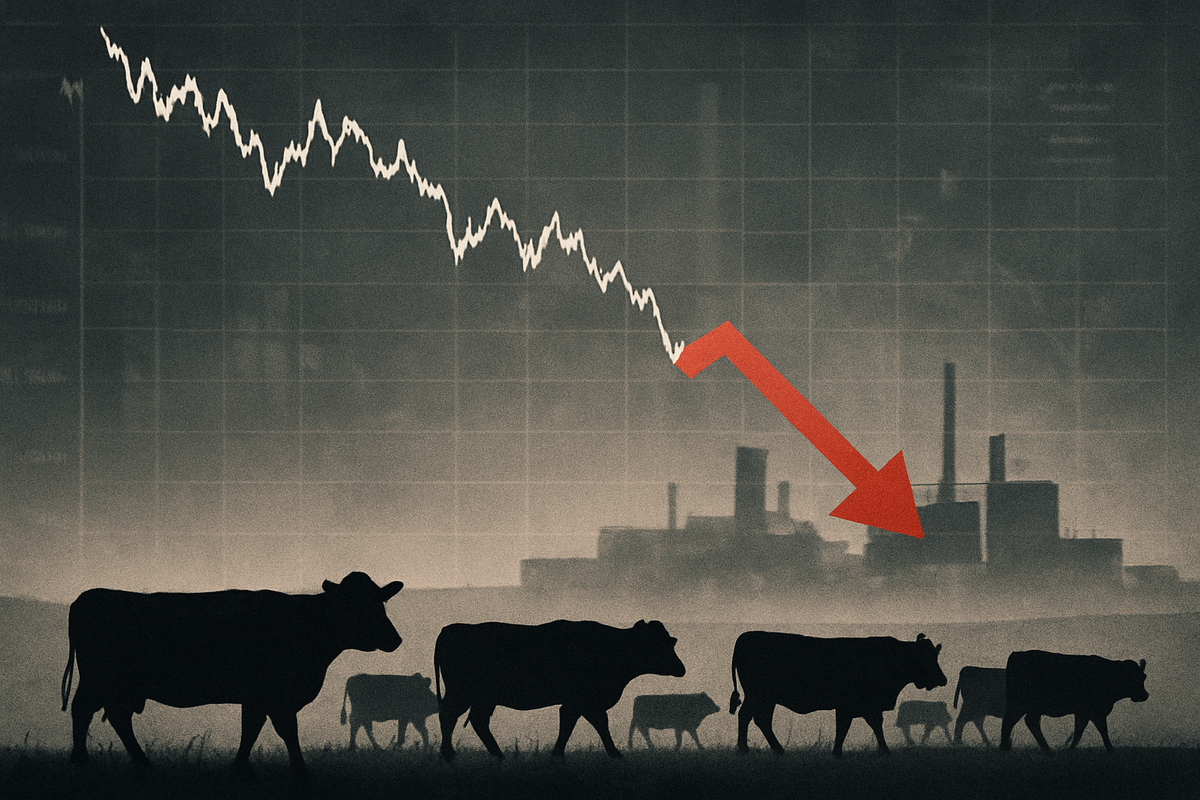
Tyson Foods (NYSE: TSN) has seen its stock price tumble to a new 52-week low of $51.07, recorded on October 14, 2025. This significant dip reflects a challenging period for the meat processing giant, underscoring persistent market pressures and growing investor concerns. As of October 24, 2025, the stock continues to grapple with headwinds, notably deepening losses in its crucial beef segment and an increasingly uncertain outlook for its previously robust chicken operations.
The decline signifies a broader underperformance compared to the wider market, with Tyson's stock shedding approximately 12.87% over the past year. While some analysts point to an oversold condition and potential undervaluation, the immediate implications for the company involve navigating severe cattle shortages, managing input costs, and adapting to evolving consumer demands, all while maintaining its long-standing dividend appeal to value-oriented investors.
Detailed Coverage of the Event
The journey to Tyson Foods' (NYSE: TSN) new 52-week low on October 14, 2025, was paved with a series of operational hurdles, strategic adjustments, and significant financial impacts throughout late 2024 and 2025. While the company initially showed signs of recovery in its chicken and prepared foods segments, persistent and deepening challenges in its Beef division ultimately weighed heavily on investor confidence.
The latter half of 2024 saw Tyson Foods report a strong finish to its fiscal year, with Q4 2024 earnings showing a significant increase in adjusted operating income and EPS. However, even then, the company's outlook for fiscal 2025 acknowledged projected operating losses in the Beef segment, citing a "dynamic" environment due to tight cattle supplies. This concern was exacerbated in December 2024 with the announcement of several plant closures, including a large beef and pork facility in Emporia, Kansas, as part of a broader cost-cutting and efficiency drive following earlier closures in 2023.
As 2025 progressed, Tyson's financial reports presented a mixed picture. Q1 2025 earnings in February initially brought optimism with strong sales and a significant jump in adjusted operating income, primarily driven by the chicken segment. Executive leadership changes, including promotions for Devin Cole and Brady Stewart, aimed to reinforce operational excellence. However, Q2 2025 results in May introduced new concerns, as a substantial $343 million legal contingency accrual drastically reduced GAAP net income, overshadowing a beat on adjusted EPS. The Beef segment continued to struggle with rising cattle costs, and the Pork segment also reported negative operating margins.
The third quarter, reported in August 2025, further compounded investor worries. Despite an increase in sales and a beat on adjusted EPS, GAAP operating income decreased significantly due to a massive $343 million goodwill impairment charge in the Beef segment. This impairment highlighted fundamental issues within the division. Compounding the instability, September 2025 saw an unexpected leadership shake-up, with Devin Cole appointed COO and Brady Stewart, previously promoted, departing due to Code of Conduct violations. This executive turnover, particularly under such circumstances, likely added to market uncertainty.
Leading up to the October 14th low, market sentiment deteriorated. The cumulative effect of mixed earnings, substantial one-time charges, and leadership instability led to multiple analyst downgrades and price target revisions. Firms like Bank of America (NYSE: BAC) and BMO Capital (TSX:BMO) lowered their targets, citing margin pressures, while Zacks Research even cut Tyson Foods from "hold" to "strong sell." Amidst these mounting pressures, and with the U.S. cattle herd remaining at multi-decade lows impacting the Beef segment's supply chain and profitability, Tyson Foods' stock ultimately succumbed, hitting its 52-week low of $51.07-$51.50 on October 14, 2025, reflecting a significant underperformance against the broader market.
Companies That Might Win or Lose
Tyson Foods' (NYSE: TSN) current predicament, stemming from severe cattle shortages, escalating input costs, and evolving consumer preferences, casts a long shadow over the traditional meat industry but simultaneously illuminates opportunities for other players. This dynamic environment creates a clear divide between potential winners and losers across the food sector.
Among the immediate beneficiaries could be Tyson's direct competitors, particularly those with a stronger emphasis on poultry and pork. Companies like Pilgrim's Pride Corporation (NASDAQ: PPC), a major poultry producer, and Hormel Foods Corporation (NYSE: HRL), with its diverse portfolio of branded pork and turkey products, might see relative gains. As beef prices soar due to scarcity, consumers are likely to shift towards more affordable protein alternatives, benefiting companies that can offer competitive pricing in these segments. Global agribusiness giants like Cargill Inc. and JBS S.A., while also exposed to beef market volatility, possess the scale and diversification to potentially navigate these challenges more effectively, leveraging their broader supply chains and processing capabilities to gain market share where Tyson falters.
However, the most significant long-term winners are poised to be companies in the alternative protein space. The confluence of high traditional meat prices, growing consumer demand for healthier and more sustainable options, and the influence of dietary trends (such as those driven by GLP-1 weight-loss drugs) provides a strong tailwind for plant-based and cultivated meat innovators. Companies such as Beyond Meat (NASDAQ: BYND) and Impossible Foods, offering plant-based meat alternatives, could become increasingly price-competitive and attractive. Ingredient suppliers like Benson Hill and Roquette Frères, which provide essential plant-based proteins, are also well-positioned to capitalize on this surge in demand. Furthermore, lab-grown meat companies like GOOD Meat (Eat Just, Inc.) and Upside Foods, having secured regulatory approvals in key markets, could accelerate their market entry and adoption as consumers seek ethically produced and environmentally friendlier meat options, especially if they can achieve cost parity with conventional meat.
Conversely, companies heavily reliant on the struggling beef segment, including Tyson Foods itself, are clearly in the "lose" category. Smaller, less diversified meat processors may find it particularly difficult to absorb prolonged high input costs and compete with larger players. Foodservice providers, especially restaurants with beef-centric menus, will face increased costs that could erode margins or force price hikes, potentially impacting customer traffic. Even animal feed suppliers, while potentially benefiting from higher commodity prices, face a mixed outlook, as reduced cattle herd sizes could eventually lessen demand for certain feeds, offset perhaps by increased poultry and pork production. Ultimately, Tyson's struggles highlight a broader industry vulnerability, pushing the entire food sector towards greater innovation and diversification in protein sources.
Wider Significance
Tyson Foods' (NYSE: TSN) descent to a 52-week low on October 14, 2025, is more than just a company-specific event; it's a potent indicator of significant shifts and enduring pressures within the broader food industry. This moment encapsulates a confluence of macroeconomic factors, evolving consumer behaviors, and a complex regulatory landscape that are reshaping how meat and protein are produced, distributed, and consumed.
At the heart of these trends lies the acute scarcity and soaring prices of beef. The U.S. cattle herd has reached multi-decade lows, a direct consequence of prolonged droughts and high feed costs forcing ranchers to downsize. This fundamental supply constraint is driving beef prices to unprecedented levels, a trend expected to persist through 2025 and beyond. For major meatpackers like Tyson, whose beef segment constitutes a substantial portion of its U.S. sales, this translates directly into higher input costs and squeezed margins. While feed costs for some grains might be easing, others, like soybean meal, remain firm, creating a "barbell economy" of expenses for producers. Simultaneously, consumer demand, while still strong for beef overall, is becoming increasingly price-sensitive, pushing shoppers towards more affordable proteins like ground beef and chicken, and favoring private-label brands. There's also a growing appetite for processed and packaged meats, as well as ethnic varieties, reflecting changing lifestyles.
These challenges create ripple effects across the entire food supply chain. Competitors such as Hormel Foods (NYSE: HRL), Kraft Heinz Co. (NASDAQ: KHC), Archer-Daniels-Midland Company (NYSE: ADM), and Bunge Limited (NYSE: BG) face similar market pressures, though their diversification across protein types or their position in agricultural commodities might offer varying degrees of resilience. Upstream, ranchers and farmers, particularly cow/calf producers, are currently benefiting from higher cattle prices, albeit against a backdrop of high feed costs and the slow process of herd rebuilding. Downstream, the foodservice industry, already grappling with labor shortages, may see further impacts as rising meat costs necessitate menu adjustments or shift consumer dining habits. The overall environment is accelerating a push towards greater innovation and diversification in protein sources, with all industry players, including Tyson's partners, needing to adapt to demands for "clean label" products, transparency, and sustainability.
Regulatory and policy implications are also playing a crucial role. The specter of import tariffs and trade wars, particularly with key partners like Mexico, introduces significant uncertainty for global meat supply chains. Domestically, potential mass deportation efforts could exacerbate agricultural labor shortages, further straining production. Moreover, stricter food safety regulations, new environmental mandates from agencies like the EPA focusing on wastewater management in processing plants, and evolving certification and labeling requirements are increasing compliance costs and operational complexities for all meat producers. These pressures, alongside broader ESG (Environmental, Social, and Governance) initiatives, are pushing the industry towards more sustainable practices and greater transparency.
Historically, the food industry has weathered similar storms. Periods of economic recession have consistently seen shifts in consumer spending towards value and at-home eating, echoing current responses to inflation. Commodity price volatility, disease outbreaks (like bird flu earlier in 2025), and corporate governance issues (such as Tyson's recent executive departures) are recurring themes that have historically disrupted supply chains and eroded investor confidence. Plant closures, like those Tyson has undertaken, are a common response to market inefficiencies or overcapacity. Tyson's current struggles thus fit into a cyclical pattern of industry challenges, albeit one intensified by contemporary factors like climate change's impact on livestock and the accelerated growth of alternative protein technologies. The company's forthcoming Q4 2025 earnings report on November 10, 2025, will be a critical juncture, offering further insight into its navigation of this complex landscape.
What Comes Next
The immediate aftermath of Tyson Foods' (NYSE: TSN) stock hitting a 52-week low presents a complex picture of both formidable challenges and strategic opportunities for the company and the wider meat industry. In the short term, over the next 6-12 months, Tyson's ability to navigate the persistent headwinds in its beef segment will be paramount. The company projects an adjusted operating loss of $375 million to $475 million for its beef segment in fiscal year 2025 due to historically low cattle availability and high prices. However, Tyson's resilience hinges on the robust performance of its chicken and prepared foods businesses, which are currently undergoing successful turnarounds and are expected to generate substantial operating income, largely offsetting the beef losses. The company's strong liquidity and focus on debt reduction also provide a crucial financial buffer.
Looking further ahead, over the next 3-5 years, the meat industry is poised for significant transformation. Global meat consumption is projected to continue rising, with poultry and pork leading the growth, offering long-term opportunities for diversified players. Tyson's strategic pivot towards higher-margin, value-added products in its prepared foods segment and international expansion efforts will be critical in reducing its reliance on volatile commodity markets. The industry as a whole will increasingly integrate advanced technologies like robotics and AI to enhance operational efficiency, address labor shortages, and improve supply chain traceability. Sustainability and ethical production will not just be regulatory requirements but also key drivers of consumer choice, compelling companies to invest in transparent and responsible practices.
Several strategic adaptations are required across the industry. Operational efficiency through automation and AI is no longer optional but essential for cost reduction and productivity. Product innovation, particularly in value-added and ready-to-eat options, will cater to changing consumer lifestyles. Building supply chain resilience against climate change, disease outbreaks, and geopolitical uncertainties will be paramount. Furthermore, while plant-based meats have faced recent headwinds, strategic engagement with the broader alternative protein market, including cultivated meat, will be crucial for long-term relevance. Tyson's existing investments in its Raised & Rooted brand indicate an awareness of this evolving landscape.
Market opportunities include the growing global demand for protein, a willingness of consumers to pay more for premium and claims-based meat products, and new avenues through e-commerce. However, significant challenges persist, such as ongoing commodity price volatility, consumer skepticism towards novel proteins like cultivated meat, intense competition, and a complex global regulatory environment for new food technologies.
Three potential scenarios emerge for Tyson and the industry. The most likely is Resilient Diversification, where Tyson leverages its strong chicken and prepared foods segments to stabilize its overall performance, while the industry focuses on efficiency and sustainability. A more challenging scenario involves Turbulent Commodity Markets, where beef struggles deepen and economic instability further reduces consumer purchasing power, forcing more aggressive cost-cutting. Finally, a transformative scenario, Accelerated Protein Transformation, envisions rapid technological breakthroughs and increased consumer acceptance leading to a quicker adoption of alternative proteins, potentially reshaping the entire protein market and requiring Tyson to significantly accelerate its own alternative protein investments. Tyson's ability to navigate these potential futures will determine its market position and investor confidence in the coming years.
Comprehensive Wrap-up
Tyson Foods' (NYSE: TSN) dip to a 52-week low of $51.07 on October 14, 2025, serves as a stark reminder of the inherent volatility and complex challenges facing the global meat industry. While the stock has seen minor fluctuations since, this critical juncture highlights persistent investor apprehension despite the company's efforts to bolster other segments.
The key takeaway from this event is the profound impact of the struggling Beef segment, which continues to be a significant drag on Tyson's overall profitability. Unprecedented cattle shortages and soaring beef prices, driven by a multi-decade low in the U.S. cattle herd, have led to projected operating losses for this crucial division. This overshadows the otherwise strong performance and successful turnaround in Tyson's Chicken and Prepared Foods segments, which have shown robust margins and operational improvements. Broader macroeconomic factors, including volatile commodity prices for feed and grains, along with lingering supply chain disruptions, further amplify the pressures on Tyson's relatively thin margins.
Moving forward, Tyson Foods presents a mixed but strategically focused picture. Its management remains committed to leveraging the strengths of its Chicken and Prepared Foods businesses through innovation, operational excellence, and a focus on value-added products. The company has reaffirmed its fiscal 2025 guidance, projecting modest sales growth and a healthy adjusted operating income, primarily cushioned by these performing segments. However, the path to recovery for the Beef segment remains uncertain, heavily dependent on the slow process of herd rebuilding and more favorable commodity cycles. The meat industry as a whole is poised for moderate global growth, particularly in poultry and beef output, but must contend with slowing per capita consumption in developed markets, a discernible shift towards poultry and alternative proteins, and increasing scrutiny on environmental and ethical practices.
The lasting significance of Tyson's current struggles lies in its potential to accelerate strategic shifts across the industry. It underscores the urgent need for major players to intensify their focus on risk mitigation within commodity-exposed segments, diversify their portfolios towards higher-margin, value-added products, and strategically engage with the burgeoning alternative protein market. This event could prompt a more aggressive re-evaluation of supply chain resilience and a deeper commitment to sustainable and transparent operational practices. For investors, it reinforces the importance of a nuanced understanding of the company's diversified segments and the broader cyclical nature of the protein market.
In the coming months, investors should closely watch Tyson's Q4 2025 earnings report, expected around November 10, 2025, for critical insights into the Beef segment's performance and management's outlook for fiscal year 2026. Monitoring trends in commodity prices for feed ingredients and live cattle will be crucial, as will observing shifts in consumer spending habits and protein preferences. Evidence of sustained operational efficiency and any significant analyst revisions will also serve as key indicators of Tyson's trajectory in this challenging yet evolving market.
This content is intended for informational purposes only and is not financial advice







